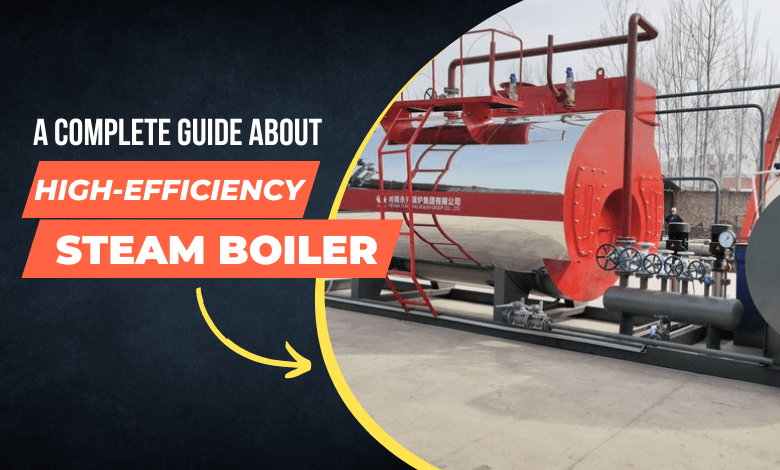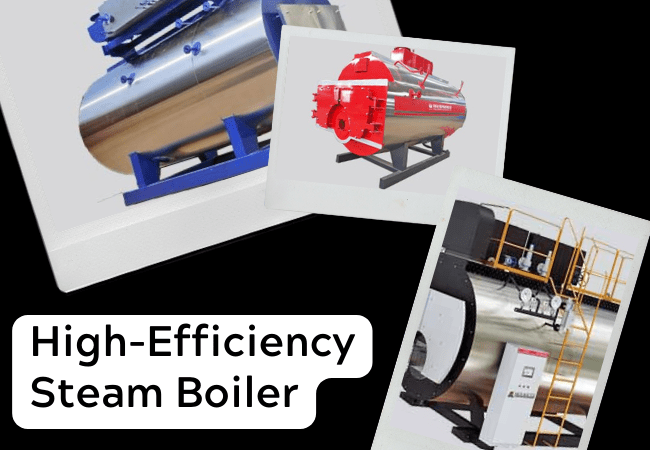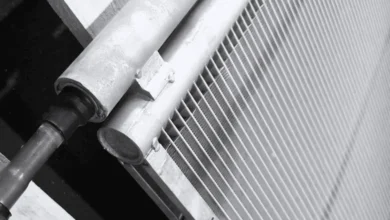A Complete Guide About High-Efficiency Steam Boiler
Everything You Need to Know About High-Efficiency Steam Boiler

A complete guide about high-efficiency steam boilers will help you learn how to improve your boiler’s efficiency, from purchasing one to re-configuring it when necessary. This manual will provide you with everything you need to know from the basics of boiler operation, to how to reconfigure your steam boiler and even how to calculate the price. Listed below are some of the most important aspects of this manual. To learn more, check out these related articles!
What is a high-efficiency steam boiler?
The efficiency of a boiler is measured in annual fuel utilization efficiency (AFUE). This metric compares the heat output per unit of fuel to the amount of fuel consumed annually. A high-efficiency boiler achieves an AFUE of 90% or higher.
This efficiency can help you save on heating costs. This boiler has a higher AFUE rating than its counterpart. The annual fuel utilization efficiency of a boiler is important because it affects the heating bills of your home.
The average lifespan of a boiler is 15 years, and with age, the boiler becomes less efficient. This means you have to pay twice as much to heat your home with a low-efficiency boiler. In addition, a low-efficiency boiler will not provide adequate heat due to trapped air or sludge, which can make it inefficient. A high-efficiency steam boiler will also give you a more even heating distribution.
The efficiency of a steam boiler is measured by its ability to produce useful heat from the fuel. It can be defined as the ratio of useful heat output to total energy input. A typical boiler’s efficiency will range from 90% for solid biomass fuels to 95% for oil-fired boilers.
However, biofuels perform poorly due to their moisture content, which increases flue gas losses. However, high-efficiency steam boilers are still better than average in many aspects.
How long does a high-efficiency steam boiler?
The lifespan of a steam boiler can vary based on several factors, including its maintenance, mileage, and type of engine. A quality boiler is able to last up to 20 years if properly maintained, but older cast iron steam boilers are unlikely to last that long.
If you’re not careful with your boiler, it may break down sooner than you expect. But you can avoid that if you know how to care for it properly.
Compared to standard boilers, high-efficiency steam boilers can save you a lot of money on your electric bills. While the lifespan of a gas boiler depends on many factors, the average lifespan is 10 to 15 years. That said, it’s always best to choose a boiler with a warranty or a good reputation. Generally, you should choose a condensing boiler.
It is also important to maintain your boiler regularly. Without regular maintenance, corrosion will eventually affect your boiler and usually require a replacement. The corrosion will occur on parts in contact with water, such as the tank and heat exchanger.
If these parts start to crack, you may have a leak of dangerous gas. To avoid these problems, you should schedule annual boiler maintenance and repairs. This way, you can ensure that your steam boiler will continue to work when you need it.
Reconfiguring a high-efficiency steam boiler
The efficiency of a typical steam boiler is not consistent throughout the lifetime of the equipment. However, switching to a boiler with real-time efficiency tracking will drastically increase its effectiveness. Maintaining the efficiency of a steam boiler is crucial to lowering energy bills and reducing your carbon footprint.
There are several components involved in this process. Hopefully, this article has been helpful. However, there may be some costs involved, such as replacing the current boiler with a high-efficiency steam boiler.
First, it is crucial to understand how your boiler’s operating mode works. Large industrial and commercial settings typically have modulating boilers that run all the time, while residential buildings tend to operate on an on-off basis. In this case, the boiler will need to produce only a portion of its maximum steam output.
It will be more efficient to use a boiler that is configured for constant operation, rather than one that only runs during peak hours.
The other component of an industrial steam boiler that affects its productivity is its environmental conditions. An industrial boiler is influenced by multiple environmental factors. By knowing which part of the system is responsible for a particular flaw, you can choose a better-functioning machine.
In this case, the air is elevated above the oxidation point, which means the temperature is above the point at which it completes oxidation. In order to achieve maximum combustion, excess steam is provided to the combustor.
Price of a high-efficiency steam boiler
A high-efficiency steam boiler costs more up front, but is well worth the price when it comes to energy savings and decreased maintenance. These units can typically pay for themselves in as little as 10 years.
They deliver heat through a series of plumbing pipes that contain heating elements such as radiators, baseboard heaters, or pipes that run through floors. This means that a high-efficiency boiler is like an in-house furnace, but it doesn’t require an HVAC system. All it needs is water.
The price of a high-efficiency steam boiler will vary depending on its fuel type. Some are fueled with natural gas, while others use propane. Natural gas is readily available in many areas but isn’t available in every state. A propane boiler will have to run on heating oil, which increases the operating cost. Depending on the cost of oil, the boiler’s lifespan may be up to 15 years, which is quite high.
Prices for high-efficiency steam boilers vary. They range from about $2,000 to $6,000. Natural-gas models, on the other hand, cost between $1,700 and $10,000. Wall-mounted boilers, for instance, are more affordable than floor-standing models.
Floor-standing models are more efficient and tend to have more features. But be sure to compare models before buying one. This way, you can make an informed decision.
Difference between high & standard efficiency boiler
There is a difference between high-efficiency steam boilers and standard-efficiency steam boilers. While both types of boilers are similar in general design and function, there are important differences between the two. Before you purchase a steam boiler, it’s important to understand its characteristics and functions so that you can make a smart decision.
Listed below are the differences between each type of boiler. To determine which type of boiler is right for your home, you need to consider its heating capacity.
Energy-efficient boilers are rated to be at least eighty percent efficient. High-efficiency boilers trap the waste heat from the heating process and channel it back into the home.
Standard boilers are inefficient and waste fuel, while high-efficiency boilers save energy and money. Old boilers typically have an efficiency rating of 50 to seventy percent. They waste between 30 and 50% of fuel while heating a house.
Burnout and flue-gas exit temperature are other factors that influence the overall efficiency of a boiler. The longer a boiler remains on standby, the more fuel it will save. For example, a 12-hour boiler will save about 5.5% of fuel compared to a twenty-four-hour boiler. Burnout is related to the amount of air in the system. A higher amount of air reduces the efficiency of a boiler.
Also Read: How to Choose a Commercial Heating & Cooling Company
Difference between high-efficiency & condensing boiler
The most significant difference between a condensing boiler and a standard-efficiency furnace is the process of condensation. A standard-efficiency furnace burns fuel and sends the hot gases through a heat exchanger, where the heat energy is transferred to the water.
A condensing boiler, on the other hand, captures most of the exhaust gas. Its condensate is slightly acidic, and the drainage system for this liquid is required.
A high-efficiency boiler reduces fuel consumption by as much as 50% and is better for the environment. It also does not have a traditional chimney, and instead uses a short PVC pipe to provide heat to the home.
Its higher efficiency also reduces the amount of carbon dioxide emitted into the environment. It will also save on electricity and water bills. However, a condensing boiler requires a skilled contractor to install it in your home.
In terms of efficiency, condensing boilers offer greater energy savings than conventional designs. Conventional boilers can run at 50% efficiency or less, so a move to a high-efficiency condensing boiler can save up to half your energy bills.
A condensing boiler is best for homes that have high energy costs, or whose heating needs are often variable. In addition to their higher efficiency, condensing boilers have other benefits that may make them the better choice for your home.
Effect of a high-efficiency steam boiler
The calorific value of a fuel can be expressed in two different ways: Gross and Net. All fuels contain hydrogen, which burns with oxygen and passes up the stack as water. The gross calorific value of fuel represents the energy it expends while burning and producing steam.
In contrast, the net calorific value represents the energy expended during the evaporation of water. However, the flue gases produced by steam boiler plants are not condensed and, therefore, reduce the actual heat available to the boiler. Hence, the higher the load, the higher the efficiency.
Using a high-efficiency steam boiler is a great investment, but it’s important to know how it works and how it benefits you. The water side of a boiler’s tubes is affected by scale and deposits. If this scale builds up, it reduces heat transfer and decreases the boiler’s efficiency.
Furthermore, scale and deposits can reduce the efficiency of a boiler by two percent, and increase the amount of fuel used by the system.
Thermal efficiency refers to the way heat is transferred from one fluid to another. It is a measure of the heat transfer between two liquids, such as water and air. It does not account for losses due to radiation or convection.
This is why the term thermal efficiency is often used in comparison to fuel-to-steam efficiency. This metric is not an accurate indicator of the overall efficiency of a boiler. Instead, it should be measured according to the manufacturer’s specifications, so you can determine the boiler’s energy efficiency.







